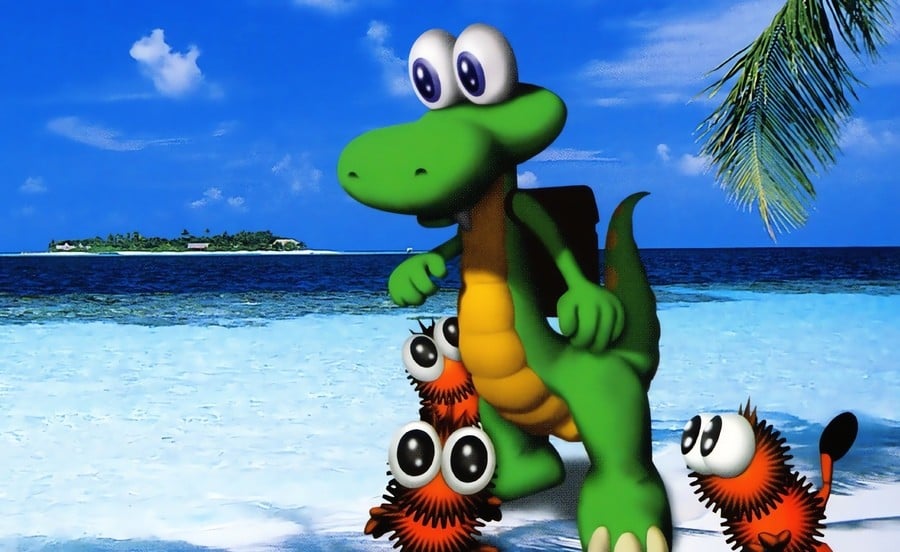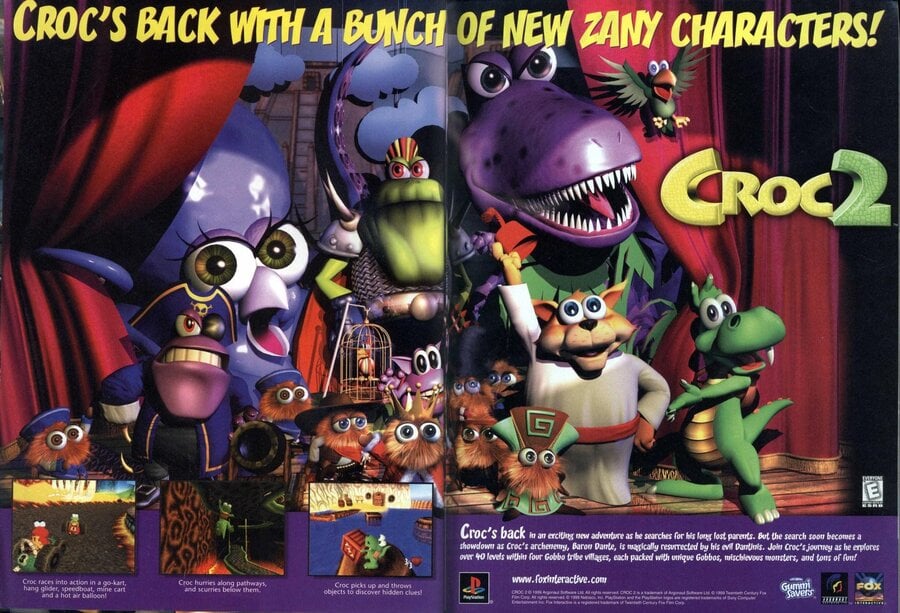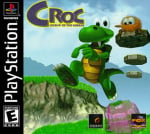
Banjo-Kazooie. Crash Bandicoot. Spyro the Dragon. And yes, Super Mario 64. These names are synonymous with defining the 3D platformer, exploring the uncharted territories of the third dimension and taking players on a journey far grander than going from the left side of the screen to the right. Yet there is one name that is less frequently discussed: Croc: Legend of the Gobbos.
Developed by Argonaut Games and released on the PlayStation, PC and Sega Saturn in 1997, Croc was a smart and stylish 3D platformer that sold over three million copies (around the same as Banjo-Kazooie) and secured its place in many a gamer's fond childhood memories. Simply shout 'Yazoo!' in a high-pitched voice, and you will instantly transport fans back to Croc's first outing.
The loveable crocodile's origins actually stem from a project involving Nintendo's own green reptile, Yoshi – although perhaps not in the way you may have read. As we've learned in the decades since Croc's debut, Argonaut had been working on a Yoshi demo: a rendered video that showed a bunch of Yoshis running around 3D Mario-style environments. Argonaut pitched this to Nintendo, but an agreement was never made – likely because the platform holder was hard at work on its own 3D outing with Super Mario 64.

"But that definitely lit a spark in terms of inspiration for how we could do a 3D platforming game at Argonaut," Nic Cusworth tells Time Extension. "I know that during the Super FX time, I thought about it a lot but I didn't see how that could really worked. The best example was Yoshi's Island which used the Super FX chip for 2D, scaling and so on. But I don't think there was a way to take the limitations on the number of polygons and the clock speed of the Super FX chip and do something that would have been a rewarding 3D platform experience."
Cusworth joined Argonaut in 1993, a few years before work began on what would become Croc. When the project was in full swing, he landed the role of lead designer – although he observes that this was an "umbrella term for a lot of different stuff back then," including level design, scripting enemies and objects and helping to shape the core gameplay.
While he wasn't involved in the earlier Yoshi demo, he remembers being shown the video and "being blown away by it," but sadly, it seems that this historical artefact has been lost to time. "I don't have a copy of it; I don't know anyone who does." He adds that Croc was not actually influenced directly by this project. "I know both characters are green, but I think that's more coincidence in terms of early character design. It definitely wasn't a case of 'Well, if we can't do Yoshi, we'll do our own Yoshi," Cusworth says.
After the Yoshi demo was rejected, Argonaut programmers Anthony Lloyd and Lewis Gordon received Sega Saturn dev kits and began testing out the hardware, trying to get a sub-baseline 3D engine and renderer up and running. A character designer at the studio created an avatar for the demo they began to work on: a chubby, cigar-chomping crocodile.
"It wasn't particularly cute; it was a little bit edgy, but that got translated into this demo that I seem to remember was essentially this character running down tubes," Cusworth explains. "I was working on Creature Shock Deluxe on the PlayStation and Saturn at the time, and Tony and Lewis were sat right around the corner, so I was constantly at their desk looking at what they were doing. When that project ended, we knew we should do something with what they'd been working on. It was very grassroots, just a few of us on board. Once we had a small team together, we basically asked, 'Well, how can we make a 3D platform game?' – because there was nothing out there to show us how to make a 3D platform game."
I know both characters are green, but I think that's more coincidence in terms of early character design. It definitely wasn't a case of 'Well, if we can't do Yoshi, we'll do our own Yoshi'
There were already rumours that Nintendo's next console was on the way, and it was clear that 3D games were going to be the big leap for the forthcoming generation. Fortunately, Argonaut already had a lot of expertise in this area. The studio famously worked with Nintendo to design the Super FX chip that enabled the 3D effects in Star Fox, but it also created similar effects on the ZX Spectrum and Commodore 64 with titles such as Starglider, while also pushing the boundaries of fully-rendered FMV games with outings such as Creature Shock.
"Internally in the studio, we never really thought about 2D," Cusworth says. "We did a couple of 2D projects, but they were licences, and they weren't great. Everyone in the studio, including me as a designer, was from day one thinking 3D. The day I started, I started work on Vortex, which was a Super FX game. But when we started Croc, especially knowing the lift in hardware we were going to, there was a question of how we even build it."
Cusworth recalls a conversation with Lloyd and Gordon, discussing how 2D development works and how that could be extrapolated for 3D. With 2D titles, developers often created tiles and placed them on a 2D plane with a location across the X and Y axes. The trio considered whether they could do the same with cubes. "We started building tools very early on to just start creating levels before we even had a character running around," Cusworth says.
"It was all about how we built the space. We were building around the early hardware limitations of PlayStation and the Saturn. The reason Mario could get away with those big open levels is because the Nintendo 64 could draw massive polygons that did not clip. The polygons needed to be so much tighter on PlayStation otherwise they just flickered out and clipped. So that's why Croc is limited to these size of rooms, because that was as much as we could render at 30 frames per second. Everything was built from these 3D tiles that fit together. It's sort of like Minecraft, but instead of having just these cubes, you have a bit more detail in them, like the edge of a lava pool or a bit more detail on the walls and the surrounds, but essentially it's a similar principle to something like Minecraft."
I remember doing a level design primer class for some of the QA team, and I was literally taking screenshots from Yoshi's Island and asking, 'What do you do in this screenshot?' You can stop any frame of Yoshi's Island and understand what is being asked of you. That was the principle we took
Some of the technology the team built for Croc formed the basis of future Argonaut games on PlayStation. The Emperor's New Groove, Disney's Aladdin in Nasira's Revenge, and even the first two Harry Potter games all used the Croc engine, and the scripting language "went on to the death of Argonaut," Cusworth adds.
While Croc: The Legend of the Gobbos was not built directly on the foundations of that lost Yoshi demo, Nintendo's iconic dinosaur did influence how the levels were designed. "I remember doing a level design primer class for some of the QA team, and I was literally taking screenshots from Yoshi's Island and asking, 'What do you do in this screenshot?'" Cusworth explains. "You can stop any frame of Yoshi's Island and understand what is being asked of you. That was the principle we took. You need to be able to understand immediately what's being asked of you, and once you've overcome that, you're on to the next 'screen' effectively, so you could almost treat those spaces as a 'screen' in a traditional 2D platform game. It was about maximising as much play time within those spaces as felt right. Depending on the spaces, I think each room took about one or two minutes to get through, so each level was between five and ten minutes. Each of those rooms needed a purpose; they needed to be clearly understood, the A to B needed to be clear, and if it wasn't, there were guides along the way – like somewhere to climb up, but once you’ve climbed up you can clearly see where you need to go."
There were limitations, of course, which frustrated the team. Cusworth wanted to build bigger rooms, bigger worlds, or even just add a few more rocks and other scenery, but this would cause the framerate to drop. The 1999 sequel, Croc 2, did have more open levels and removed more of the doorways so that gameplay flowed a little better, but this came at the cost of not being able to see the entire room in one go. "I think the reason people love Croc 1 more than Croc 2 is because of that simplicity," says Cusworth. "Because it was a clear goal and you knew how to complete it, you knew you get through that door and on to the next thing or on to the end. We lost some of that [in Croc 2]."

Controls were another limitation. While Mario and Banjo benefitted from the Nintendo 64's analogue stick, Croc was developed for the PlayStation and Saturn, which used directional buttons, and PC, which used the arrow keys. So while players could see 360 degrees of space around them, Croc could only move in eight directions.
In a case of unfortunate timing, Argonaut received the PlayStation analogue controller roughly two weeks before the game went gold. The team was able to add support, but due to the late stage of development, it had to simply mimic the digital pad's controls. "What you get is what some people call 'tank controls', or something like the original Tomb Raider controls, which is where you turn your character, you run forward, you turn them, you run," says Cusworth.
"It was the only thing that made sense to us, given that we built the game on a digital pad. You could argue that maybe you could have gotten some of that analogue feel with a digital pad – if you pull backward, you run into the screen, that kind of stuff – but it would have felt so locked to those eight axes." Again, this was addressed in the sequel, with Croc 2 boasting Mario-style controls. But Cusworth notes that the team "messed the camera up so horrendously bad," the game was still a little difficult to play.
By the time Croc arrived in 1997, the world had already had its first taste of 3D platforming in Mario 64 and the original Crash Bandicoot, with Banjo and Spyro to following in the next twelve months. While Croc may seem to pale in comparison, it's important to recognise the challenges Argonaut faced when building one of the first games of its type.

"There simply wasn't anything to refer to during development, and then when things did come out, it was too late – we'd already taken an approach," Cusworth says. "The first 3D platformer I remember playing was Bubsy 3D, which is now a notorious title, unfortunately, but they were facing exactly the same things that we were. How do you do this? How do you take a 2D game and make it 3D? [Crash Bandicoot] is stunning, it's on another level compared to Croc, but it's because they focused on that corridor [structure], you're able to increase the density around the character because you're going down a tunnel. If it ever gets too much, you can always turn a corner, and then the draw distance is not a problem; you can hide it in so many different ways. We'd already taken this room-based approach, building out tiles."
The first 3D platformer I remember playing was Bubsy 3D, which is now a notorious title, unfortunately, but they were facing exactly the same things that we were. How do you do this? How do you take a 2D game and make it 3D?
Similarly, the limitations of the PlayStation remained an issue, with Cusworth observing you could never have made Mario 64 for Sony's hardware. He recalls being stunned the first time he was Nintendo's game in action on Bad Influence, a '90s video games show for UK channel ITV, but again emphasises it was too late to change direction without risking the possibility that Croc would never ship.
Mario has, unsurprisingly, endured, and Banjo-Kazooie went on to garner higher sales and more sequels than Croc. Even Spyro and Crash have made comebacks over the past few decades, and yet Croc remains trapped in the previous millennium – you can't even buy the original game on Steam or GOG, nor has there been any word of a remaster. The heartbreaking thing is Fox Interactive, part of 20th Century Fox, clearly had ambitions for Croc, with plans to make the series a multimedia franchise – although details on how this would have looked remain scarce.
"They had some scripts done [for a cartoon] by some of The Simpsons writers, and one of them wrote the story in Croc 1's manual," Cusworth recalls. "We got it back, and it had no resemblance to the game we were making, but back in those times, some writer would have just been asked for a backstory to a video game, taken one look at it, and put something together. I don't know who exactly worked on it, but they never talked to us. They probably did talk to Fox."

Cusworth never saw the scripts for the Croc cartoon, but he notes that the late '90s was not quite the right time to be launching a multimedia franchise based on a video game character. He remembers a Beanie Baby toy of Croc, but believes they were "pretty rare" and says with a smile that there are a few fans making plush toys and other memorabilia on Etsy. Yet such products were harder to sell around the time of launch.
"Games were second-class citizens in the entertainment industry back then," he explains. "If you weren't Mario or Sonic, it was probably never going to really happen. But obviously, Fox being Fox, they wanted to try some stuff and see what could happen, but it never went anywhere."
Croc remains stuck in limbo; a commercial success at the time of release, but no longer famous enough to be considered a candidate for a remaster. Cusworth admits that there's part of him that isn't all that shocked that the character didn't go on to attain Mario levels of fame. "The PlayStation changed a lot for the games industry, but that change still took a few years to filter through before games were more widely accepted as a cultural entertainment, that they weren't just for kids. Sony needs to be credited for that, for pushing the message that games were for everyone. But given how things were at the time, I'm not surprised nothing else came from Croc – and if something had, god knows what it would have been."






